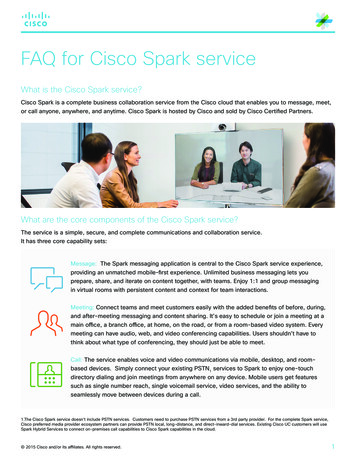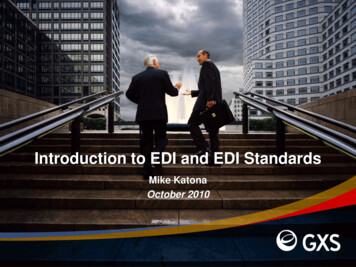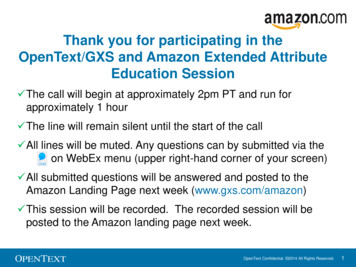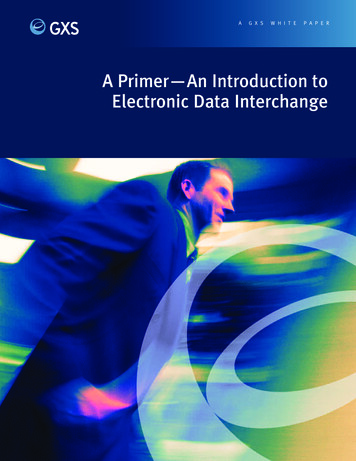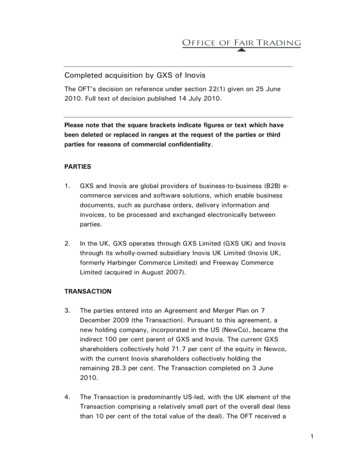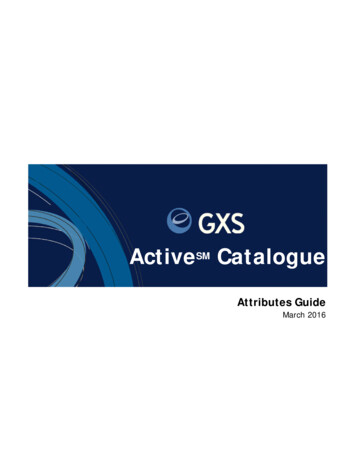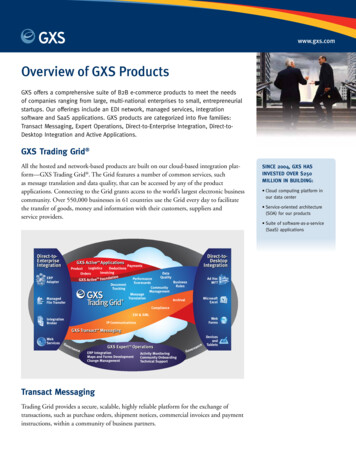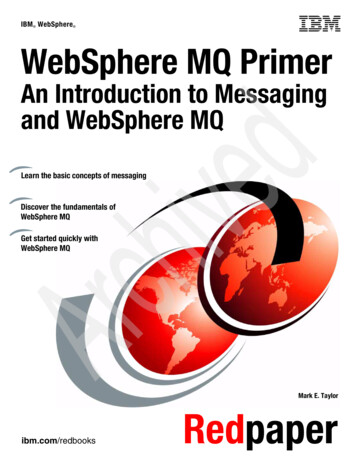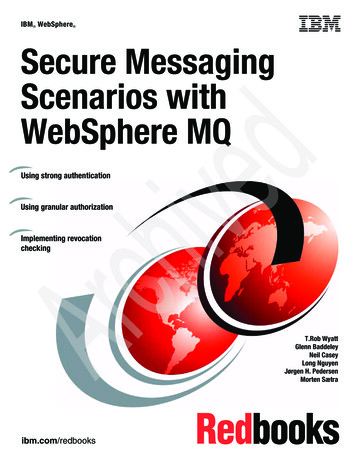
Transcription
GXS Trading GridMessaging Service Connectivity OverviewA GXS TransactSM Messaging Service for the Active Business
Table of ContentsIntroduction. 3Trading Grid Messaging Service Connectivity Options Matrix. 4AS2 . 5AS3 . 6FTP . 7SFTP . 8FTPS. 9HTTPS (scripted).10Trading Grid Online (HTTPS). 11GXS TP Client (HTTPS).12MQ .13OFTP.14OFTP2.15X.400.162 GXS Trading Grid Messaging ServiceConnectivity Overview
IntroductionThe GXS Trading Grid Messaging Service (TGMS) offers a broad set of connectivity options to meet the needs ofcompanies large and small, of varying technical levels and with different business requirements. This document providesguidance on choosing an appropriate connectivity option to best meet your company’s data exchange needs.TGMS connectivity options include: AS2AS3FTPFTPSSFTPHTTPS (scripted)Trading Grid Online (HTTPS)GXS TP Client (HTTPS)MQOFTPOFTP2X.400Some of these connectivity options provide similar functionality. When choosing the best option for your company,beyond meeting your minimum business and technical requirements, some of the leading decision criteria should beyour familiarity, expertise and in-house technical capabilities with the connectivity solution.If you have questions on any of these connectivity options, or on any potential option not included in this list pleasecontact your local GXS representative. Contact details can be found on our website at www.gxs.com/contact/.Licenses and TrademarksTrading Grid is a registered trademark of GXS, Inc.Other trade names used in this document are the trademarks or service marks of their respective owners.GXS Trading Grid Messaging Service 3Connectivity Overview
Trading Grid Messaging Service Connectivity Options MatrixConnectivity OptionClientSoftware Data TypesAS2Drummond CertifiedrecommendedInternetPublic key, SSL optionalAny (Non-EDI data .types require specialconfiguration)AS3Drummond CertifiedrecommendedInternetPublic key, SSL, .User ID/PasswordAny (Non-EDI data .types require specialconfiguration)FTPAny FTPAny method other thanopen Internet (examplesinclude VPN, leasedline, frame relay, etc.)User ID/password, Additional security dependson physical connectivityAnySFTPAny SFTPInternetSSH, User ID/password,public key (optional)AnyFTPSGXS-qualified FTPS .software onlyInternetSSL, User ID/passwordAnyHTTPS (scripted)Any HTTP scripting .languageInternetSSL, User ID/PasswordAnyTrading Grid Online(HTTPS)Internet Explorer orFirefoxInternetUser ID/Password, SSLAnyGXS TP Client (HTTPS)GXS TP ClientInternetSSL, User ID/PasswordAnyMQIBM WebSphere MQ .or MQ-capable softwareClosed circuit IP (leasedline, frame relay, etc.)or VPN gatewayNetwork: VPN/IPSec .or closed circuitApplication: SSLAnyOFTPAny OFTPX.25, ISDN, closedcircuit IP (leased line,frame relay, etc.) or VPN(including ANX & ENX)Network: VPN/IPSec, .Dialup .Application:SSID/PasswordAnyOFTP2Any OFTPInternetSSL,SSID/Password,Public key (optional)AnyX.400Any MTAX.25,closed circuit IP(leased line, framerelay, etc.) or VPNNetwork: VPN/IPSecApplication: MTAName,PasswordAny4 GXS Trading Grid Messaging ServiceConnectivity Overview
AS2EDIINT AS2 (Applicability Statement 2) is a specification developed as part of the IETF EDIINTWork Group that defines communication of EDI or other business-to-business data over the Internet using HTTP. AS2 provides security for the transport payload through digital signatures and dataencryption. It ensures reliable delivery and non-repudiation through the use of message dispositionacknowledgements (MDNs). AS2 software interoperability certification testing is performed by theDrummond Group (www.drummondgroup.com).Physical Connectivity: InternetSecurity: Public key, SSL optionalReceive (Push/Pull): PushData Types: Any (TGMS routing of non-EDI data requires special configuration)Software Client Options: Drummond Certified clients recommendedAdvantages: Real-time delivery, widespread acceptance, security and non-repudiation, utilizes theInternetDisadvantages: Expensive software, firewall considerationsRequirements for connecting to TGMS via AS2: Drummond Certified AS2 software (recommended)X.509 certificatePersistent internet connectionServer availability 24x7Factors for considering AS2 connectivity to TGMS: Already have AS2 softwareNeed real-time transaction exchangeLarge number of small/medium size filesPrimarily EDI dataConsidering hybrid approach (point-to-point AS2 with some partners, the rest managedthrough TGMS) Want to leverage Internet connectivityGXS Trading Grid Messaging Service 5Connectivity Overview
AS3EDIINT AS3 (Applicability Statement 3) is a specification developed as part of the IETFEDIINT Work Group that defines communication of EDI or other business-to-businessdata over the Internet using FTP. AS3 provides security for the transport payload throughdigital signatures and data encryption. It ensures reliable delivery and non-repudiationthrough the use of message disposition acknowledgements (MDNs). AS3 softwareinteroperability certification testing is performed by the Drummond Group(www.drummondgroup.com).Physical Connectivity: InternetSecurity: Public key, SSL/TLS, User ID/PasswordReceive Push/Pull: PullData Types: Any (TGMS routing of non-EDI data requires special configuration)Software Client Options: Drummond Certified clients recommendedAdvantages: Security and non-repudiation, utilizes the InternetDisadvantages: Expensive software, firewall considerationsRequirements for connecting to TGMS via AS3: Drummond Certified AS3 software (recommended) X.509 certificate Internet connectivityFactors for considering AS3 connectivity to TGMS: Already have AS3 software Primarily EDI data Considering hybrid approach (point-to-point AS3 with some partners, the restmanaged through TGMS) Want to leverage Internet connectivity6 GXS Trading Grid Messaging ServiceConnectivity Overview
FTPFile Transfer Protocol (FTP) is a commonly used protocol for exchanging files over anynetwork that supports the TCP/IP protocol (such as the Internet). Virtually every computer platform supports the FTP protocol. This allows any computer connected to a TCP/IP-based network to manipulate files on another computer on that network regardless ofwhich operating systems are involved. There are many existing FTP client and server programs. Trading Grid FTP connectivity uses standard FTP (File Transfer Protocol, specification RFC 959) services and requires a private connection for security. Open FTP over theInternet to TGMS is not allowed. The implementation and technical details for using FTPconnectivity will vary greatly depending on private connectivity option selected. Privateconnectivity options include: VPN Security Remote—Standalone PC or LAN software that provides VPN connectivity over an Internet connection. This software can be obtained through GXS. VPN Security Gateway—Provides host-to-host VPN connectivity via a TCP/IPconnection. Requires two Internet-routable IP addresses or the ability to performNetwork Address Translation (NAT) and an IPSec-compliant firewall. Leased Line, Frame Relay, MPLS—These are all examples of private, point-to-pointconnectivity options. These types of private connectivity options are provided bynetwork providers such as Verizon and AT&T. Dial PPP—Dial PPP is a standard method for accessing Internet Protocol (IP)-basedapplications via dial up connectivity; it is available at speeds up to 56 kbps throughthe GXS service.Physical Connectivity: Any method other than open Internet (examples include VPN,leased line, frame relay)Security: User ID/Password, dependent upon physical connectivity securityReceive Push/Pull: Pull, Push (optional with some physical connectivity methods)Data Types: AnySoftware Client Options: Any FTP softwareAdvantages: Support for large files, can use any FTP software, security of privateconnectionDisadvantages: Cannot use the open Internet, firewall considerationsRequirements for connecting to TGMS via FTP: FTP software Private connectivity (VPN, leased line, frame relay, etc.)Factors for considering FTP connectivity to TGMS: Familiar with FTP and use FTP for other applicationsEDI and/or non-EDI dataAccess to private connectivity options (VPN, leased line, frame relay, etc.)Want security of private connection versus Internet connectivityGXS Trading Grid Messaging Service 7Connectivity Overview
SFTPSFTP (SSH File Transfer Protocol) connectivity to TGMS is built upon the standard SFTPprotocol as defined by the IETF SECSH working group. SFTP connectivity to the TradingGrid only supports SSH-2 protocol, which is the most typical implementation of SFTP.SFTP connectivity to the Trading Grid Messaging Service supports SSH public key authentication and User ID/password authentication. It will first attempt SSH public keyauthentication and if that fails User ID/password authentication will be performed. ForSSH2, either the RSA or DSA public key encryption algorithms can be used. Key lengthsof 1024 (default) or 2048 are supported.Physical Connectivity: InternetSecurity: User ID/Password, SSH-2 secure shell, public key optionalReceive Push/Pull: PullData Types: AnySoftware Client Options: Any SFTP capable software that supports SSH-2Advantages: Many client software options, low cost client software options, utilizes theInternetDisadvantages: No standard support for non-repudiation, firewall considerationsRequirements for connecting to TGMS via SFTP: SFTP software Internet connectivityFactors for considering SFTP connectivity to TGMS: Experienced with and already have SFTP softwareWant to leverage Internet connectivityEDI and/or non-EDI dataMany client software options8 GXS Trading Grid Messaging ServiceConnectivity Overview
FTPSTrading Grid FTPS connectivity uses standard FTP (File Transfer Protocol, specificationRFC 959) services and simply adds a secured tunnel through the Internet using SecureSockets Layer (SSL)/Transport Layer Security (TLS).Qualified Client Software (as of 01/12/2011): Ascential DataStage TX, Release 7.5 (now IBM)Cleo Lexicom 4.1eBridge FTPS Communicator for GXS version 5.3Edisoft Merchant 4.0Future 3—Advanced Communication Module Plus (ACM Plus)Inovis BizConnect Software, version 3.0.2.361nuBridges truExchange (formerly TrailBlazer ZMOD FTP Client V3R1 PTF LevelPFT3100034)QualEDI for Windows, 32-bit versionREIMS B2B Frameworks version V5ReRobo-FTP version 3.2Seeburger Business Integration Server (BIS ) Version 5.5.1Physical Connectivity: InternetSecurity: SSL/TLS, User ID/PasswordReceive Push/Pull: PullData Types: AnySoftware Client Options: Only GXS qualified clientsAdvantages: Utilizes the InternetDisadvantages: Limited client software choices, no standard support for non-repudiation,firewall considerationsRequirements for connecting to TGMS via FTPS: GXS-qualified FTPS software Internet connectivityFactors for considering FTPS connectivity to TGMS: Already have a GXS-qualified FTPS software client Want to leverage Internet connectivity EDI and/or non-EDI dataGXS Trading Grid Messaging Service 9Connectivity Overview
HTTPS (scripted)HTTP is a popular request/response protocol in use every day by web browsers and webservers. Security is provided by delivering normal HTTP interaction over encrypted SecureSockets Layer (SSL). There are many free scripting tools available, such as Perl or Ruby,that customer can use to interact with the Trading Grid via the HTTPS protocol.Unsecured HTTP connectivity to the Trading Grid is not allowed.HTTPS connectivity to the Trading Grid further defines a subset of the header fieldsfor routing and message handling. GXS customers using HTTPS to exchange messagesthrough the Trading Grid must follow these specific header fields when sending and receiving documents.Physical Connectivity: InternetSecurity: SSL, User ID/PasswordReceive Push/Pull: Pull or PushData Types: AnySoftware Client Options: Any HTTPS software client or scripting language that can con-form to GXS’s required request header formatsAdvantages: Potential for custom integration, utilizes the InternetDisadvantages: Must conform to GXS’s request header specifications, custom integrationon customer side likely required, large files not supportedRequirements for connecting to TGMS via scripted HTTPS: HTTP scripting language and ability to create HTTP scripts Internet connectivityFactors for considering scripted HTTPS connectivity to TGMS: Experienced with HTTP scriptingAbility to customize internal integrationWant to leverage Internet connectivitySmall file sizesNo client software costs10 GXS Trading Grid Messaging ServiceConnectivity Overview
Trading Grid Online (HTTPS)Trading Grid Online (TGO) provides a web-based portal interface for uploading anddownloading files between you and TGMS. Once you are logged in to Trading GridOnline (TGO), you can select files for upload or download and then the files are deliveredover an HTTPS connection.Physical Connectivity: InternetSecurity: User ID/Password, SSLReceive Push/Pull: PullData Types: AnySoftware Client Options: Internet Explorer or FirefoxAdvantages: No software costs, utilizes the Internet, simple interfaceDisadvantages: Manual effort to upload and download files, not ideal for high transactionvolumesRequirements for connecting to TGMS via TGO: Internet Explorer or Firefox Internet connectivityFactors for considering TGO connectivity to TGMS: Very low volumes, willing to manually upload and download files Want to leverage Internet connectivity Want to avoid any software costsGXS Trading Grid Messaging Service 11Connectivity Overview
GXS TP Client (HTTPS)GXS TP Client (TPC) is a free download available to GXS customers which providesconnectivity exclusively to the Trading Grid. TPC provides a communications tool, a basicin-box/out-box interface, and a comprehensive task manager for automating and scheduling events. TPC uses HTTPS for file transfer.Physical Connectivity: InternetSecurity: SSL, User ID/PasswordReceive Push/Pull: PullData Types: AnySoftware Client Options: GXS TP ClientAdvantages: Complete GXS solution, free and easy to installDisadvantages: No support for direct connections with other partners, no security, limitedfunctionalityRequirements for connecting to TGMS via GXS TP Client: GXS TP Client software Windows-based PC Internet connectivityFactors for considering GXS TP Client connectivity to TGMS: Low data volumes No cost for client software Want to leverage Internet connectivity12 GXS Trading Grid Messaging ServiceConnectivity Overview
MQMQ is a connectivity option offered to customers using IBM’s WebSphere MQ as aprimary method of moving business documents within their business. WebSphere MQis a widely available multi-platform message-oriented middleware software suite thatprovides an event-driven communication method, integrating GXS services into theclient’s back-end system.Physical Connectivity: VPN Gateway, other IP connectivity (leased line, frame relay, etc.)Security: VPN IPSec, closed circuitReceive Push/Pull: PushData Types: AnySoftware Client Options: IBM WebSphere MQ Manager software (MQ client notsupported), JMS software that can support the IBM WebSphere MQ protocolAdvantages: Real-time, push delivery, integration directly with internal middleware systemDisadvantages: Requires IBM WebSphere MQ Manager or other MQ capable software,extensive configuration/implementationRequirements for connecting to TGMS via MQ: IBM WebSphere MQ or MQ capable software Private connectivity (VPN, leased line, frame relay, etc.)Factors for considering MQ connectivity to TGMS: Already using IBM WebSphere MQ in-houseAccess to private connectivity options (VPN, leased line, frame relay, etc.)Need real-time transaction exchangeNeed assured delivery features of WebSphere MQNeed tight integration with internal processesGXS Trading Grid Messaging Service 13Connectivity Overview
OFTPODETTE FTP (OFTP) support is of particular relevance to the automotive sector inEurope. TGMS supports connectivity using the OFTP communications protocol,including: OFTP over X.25 (incl. X28) OFTP over ISDN (incl. X31) OFTP over IP (over the ENX network) OFTP Push—TGMS will proactively deliver data to client premises using OFTP VFN support—TGMS will accept data that contains a VFN (Virtual File Name)and will route the VFN with the data to OFTP or X.400 trading partners. ASCII/EBCDIC transliteration End-to-end response (EERP)Physical Connectivity: X.25, ISDN, IP, ENX, ANXSecurity: Standard network security, SSID/PasswordReceive Push/Pull: Pull, Push (optional)Data Types: AnySoftware Client Options: Any OFTP clientAdvantages: Reliable, stableDisadvantages: Security, requires OFTP expertiseRequirements for connecting to TGMS via OFTP: OFTP client software X.25, ISDN, IP, ENX, ANXFactors for considering OFTP connectivity to TGMS: Already using OFTP in house Need end-to-end delivery notifications14 GXS Trading Grid Messaging ServiceConnectivity Overview
OFTP2The latest version of the OFTP protocol is version 2, known as OFTP2. This versionis mainly intended for secure data exchange over the public Internet, where security isguaranteed by the use of security certificates.Physical Connectivity: InternetSecurity: SSL, SSID/Password, PublicKey (optional)Receive Push/Pull: Pull, Push (optional)Data Types: AnySoftware Client Options: Any OFTP2 clientAdvantages: Internet connectivity, security, emerging standard, certified compatible clientoptions, real time exchange optionDisadvantages: Limited acceptance outside of Europe, software costsRequirements for connecting to TGMS via OFTP2: OFTP2 client software Internet connectivityFactors for considering OFTP2 connectivity to TGMS: Already have OFTP2 softwareNeed real-time transaction exchangeHandles small and large filesConsidering hybrid approach (point-to-point OFTP2 with some partners,the rest managed through TGMS) Want to leverage Internet connecti
File Transfer Protocol (FTP) is a commonly used protocol for exchanging files over any network that supports the TCP/IP protocol (such as the Internet). Virtually every com-puter platform supports the FTP protocol. This allows any computer connected to a TCP/ . Cleo Lexicom 4.1 .

